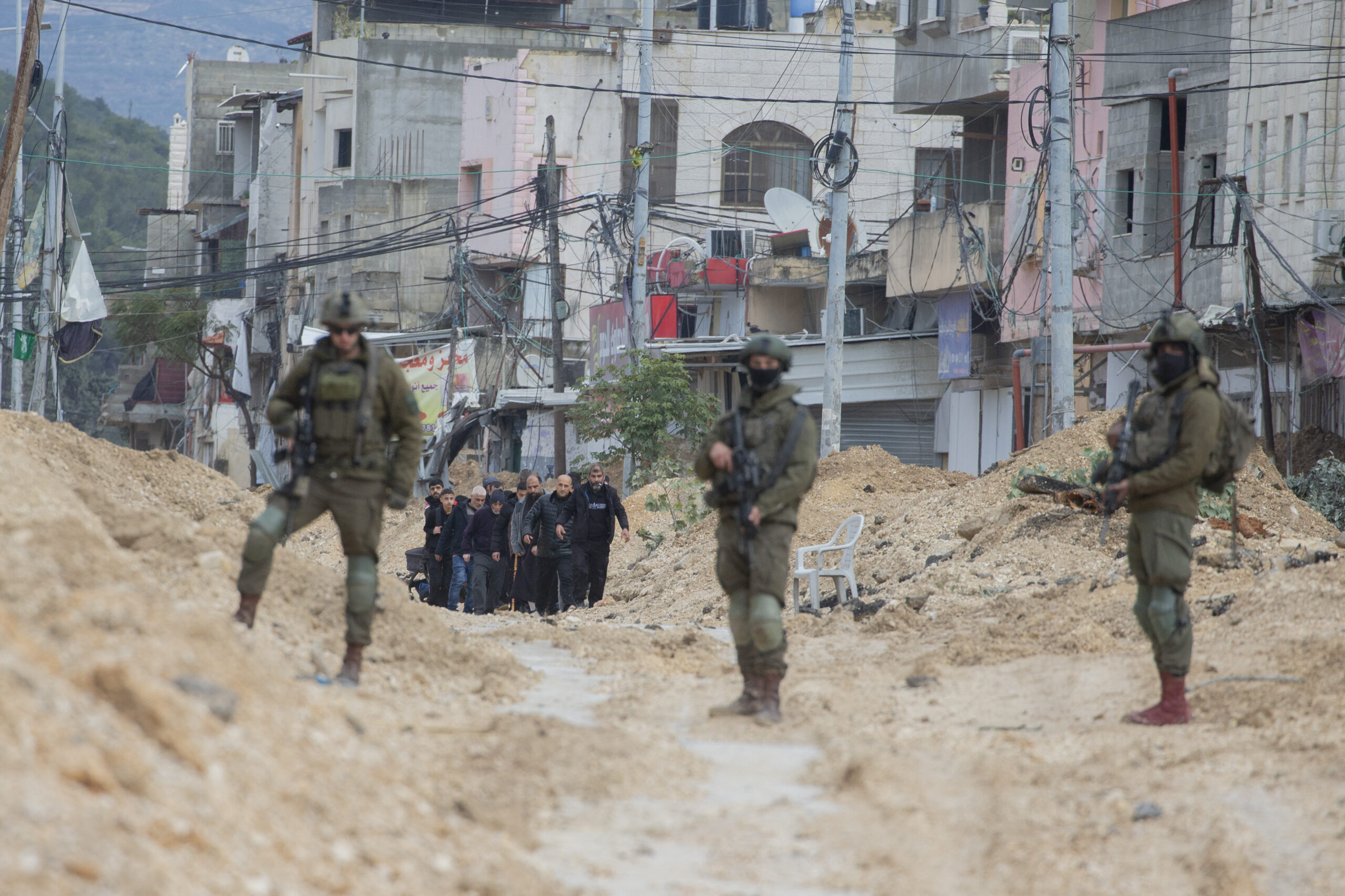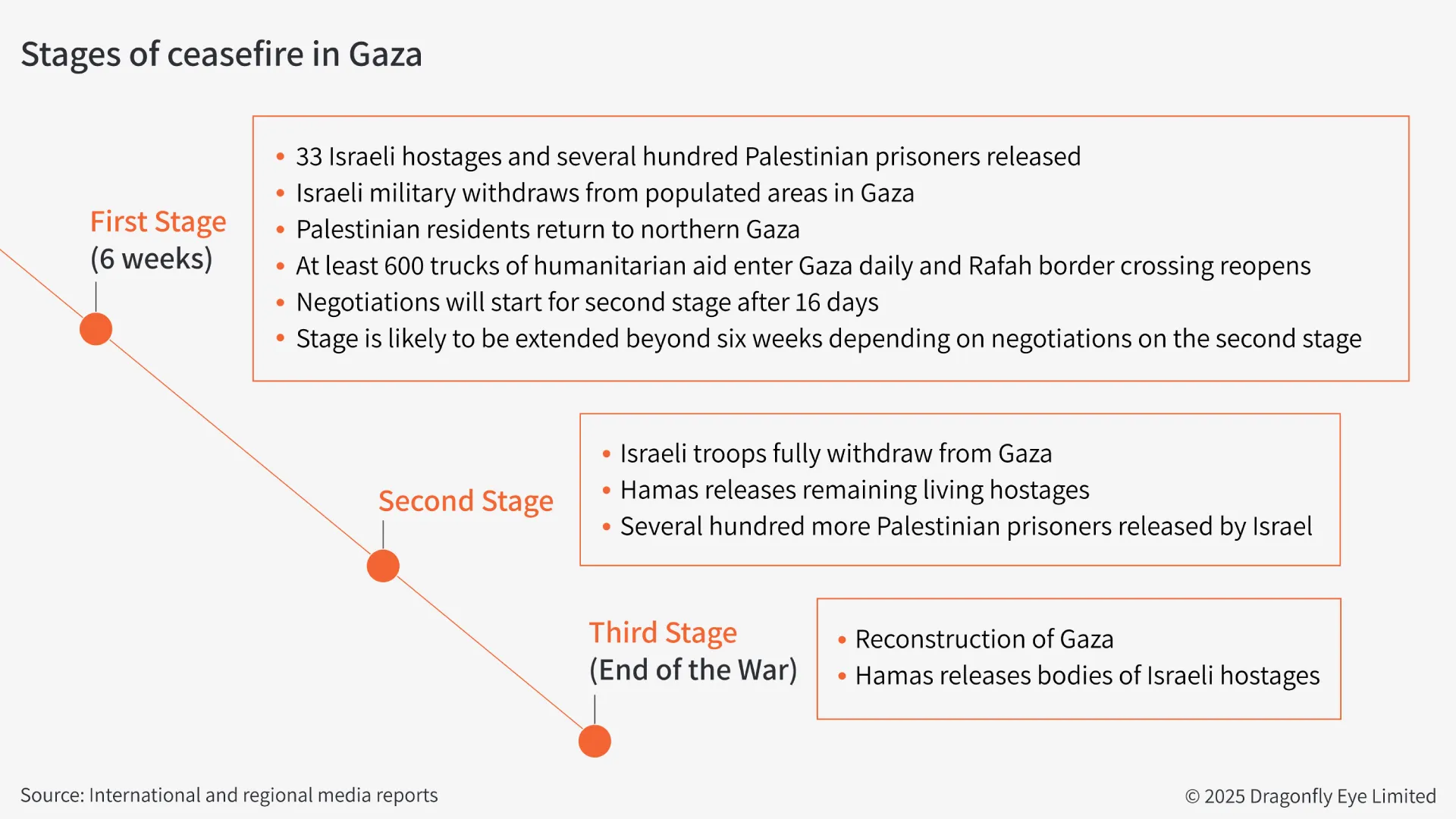A ceasefire between Israel and Hamas remains extremely fragile
This assessment was issued to clients of Dragonfly’s Security Intelligence & Analysis Service (SIAS) on 14 February 2025.
- Both sides have largely adhered to the terms of the first phase, which is due to expire at the end of the month
- The collapse of the truce would almost certainly motivate the Houthis in Yemen to resume attacks against Israel and shipping in the Red Sea
A ceasefire between Israel and Hamas is likely to stall in the coming weeks. The first phase of the truce is scheduled to end at the end of the month; it has so far involved the release of 21 Israeli hostages and the partial withdrawal of Israeli troops from northern Gaza. But there are strong signs – namely the stark divergence in what both sides would accept for the future of governance in Gaza – that Israel and Hamas will fail to agree on the terms to transition to the second phase of the deal. This phase is meant to involve Hamas releasing the remaining living hostages and Israel fully withdrawing its troops from Gaza.
The collapse of the ceasefire in Gaza would almost certainly elevate already-high regional conflict risks. We anticipate that the Houthis in Yemen would pose the most pressing threat, both to Israel and commercial shipping in the Red Sea. This is because Hezbollah in Lebanon, pro-Iran militias in Syria and Iran itself were militarily weakened at the end of 2024 and do not appear to be in a position to resume fighting. They all appear highly averse to another confrontation with Israel. The moderate to severe terrorism threat regionally would probably remain elevated irrespective of the ceasefire. As would the high chance of large pro-Palestine protests regionwide.
Ceasefire extremely liable to collapse
We assess that the ceasefire between Israel and Hamas will hold until the end of February. Both sides have largely adhered to the first phase. Until now, Hamas has released all the hostages it said it would. And Israel has allowed humanitarian aid into Gaza, as well as withdrawing from the Netzarim corridor that separates the north of Gaza from the rest of the territory. There seems to be domestic public pressure on both sides to sustain the ceasefire. For Hamas, the ceasefire has allowed displaced Gazans to return to their homes. And for Israel, it has enabled the release of hostages – a key demand of government critics and protesters last year.
The deal is extremely fragile, though. On 10 February, Hamas said it was delaying the next hostage release (set for 15 February) due to Israeli ceasefire violations. In response, Israel reportedly cancelled leave for all its military divisions in Gaza, seemingly preparing for a resumption of fighting. US President Donald Trump threatened that ‘hell’ would break loose if ‘all the hostages’ are not released by 15 February. But reliable Israeli press reports today, 11 February suggested that the Israeli cabinet is ‘willing’ to continue the ceasefire if Hamas releases all nine hostages slated for release in the first phase on 15 February.
We forecast that Hamas will probably release the next round of hostages this week. Even though Trump did not explain how the US and Israel would react to them failing to deliver the hostages, it seems reasonable to assume he was alluding to supporting a resumption of Israeli military action in Gaza until Hamas releases more hostages. In any event, the recent uncertainty about the process shows the agreement is liable to collapse at short notice.
Phase two seems improbable
There are no viable proposals for governance in Gaza post-conflict that meet the demands of all sides. This is what phase two (a full Israeli withdrawal from Gaza) hinges on, in our analysis. Trump’s proposal last week for the US to take ownership of Gaza was unanimously rejected by Arab countries. We strongly doubt that Israel and the US will be able to decide on the future of Gaza without regional support, not least because both countries seem focused on Israel and Saudi Arabia establishing diplomatic ties. But Riyadh says there will be no deal without a plan for Palestinian statehood.
Hamas’ continued existence is another major obstacle. Even if there was international consensus on how Gaza should be governed, Israel continues to insist that it will not accept any Hamas involvement in Gaza affairs post-conflict. The group has continued to demonstrate its influence in Gaza. Dozens of armed Hamas fighters in full military fatigue have been present during hostage releases over the past month. This suggests the group is still active, which is at odds with Israel’s stated war objective to ‘eliminate’ Hamas.
Given this, we forecast that the ceasefire will collapse or become ineffective in the coming weeks. In our view, given the domestic pressure on both sides to pursue peace, the deal could become ineffective without officially collapsing. This would probably involve a halt to hostage releases and a resumption of targeted military operations by Israel in Gaza, including sporadic Israeli air strikes. We have identified some indicators (in no particular order of likelihood) that this is becoming likely and potentially imminent:
- US private security firms managing checkpoints in Gaza begin to withdraw personnel from the territory
- Hamas says it will not release any more hostages until Israel withdraws from Gaza
- Israel publicly rules out a full military withdrawal from Gaza
- Hamas executes an Israeli hostage
In our analysis, a collapse of the deal would most likely be prompted by Hamas refusing to release any more hostages until the second phase is agreed. Or by Israel ruling out a full withdrawal from Gaza any time soon. But even without collapse, negotiations for the second phase are likely to stall, and so make the ceasefire ineffective.
We have also identified some indicators that suggest a transition to the second phase of the ceasefire is likely. These are in no particular order:
- Israel signals it is prepared to accept Palestinian control of Gaza (such as by the Palestinian Authority)
- Arab countries propose a peacekeeping force to manage security in Gaza during any transitional period
- Senior Hamas fighters agree to leave Gaza
Ceasefire breakdown would raise regional conflict risks again
Should the ceasefire collapse, we assess that the Houthis in Yemen would pose the most pressing threat to Israel and commercial shipping in the Red Sea. The group has not mounted any drone and missile attacks in the Red Sea or against Israel since the Gaza ceasefire came into effect. But in our view, this is probably because the group views the truce as an opportunity to regroup and avoid retaliatory US, UK and Israeli attacks against it. It has said its actions against Israel and the Red Sea would resume should Israel violate the ceasefire.
In any event, the threat of missile strikes from Hezbollah in Lebanon against Israel is likely to remain low over the coming months. Hezbollah has suffered heavy losses at the hands of Israeli military operations throughout 2024. A ceasefire between Israel and Hezbollah is still holding despite near-daily violations by the former; Hezbollah seems highly averse to another confrontation with Israel. This is not least because the fall of the Assad regime in Syria – according to OSINT experts – has significantly disrupted a supply route between Lebanon and Syria that pro-Iran groups had used to coordinate attacks against Israel.
We do not anticipate a significant change to security and safety risks in Israeli cities over the coming months, irrespective of the Gaza ceasefire holding. This is largely because Israeli military operations during 2024 have effectively diminished the capability and willingness of Hamas, Hezbollah and militias in Syria to attack Israel. Most Houthi attacks during 2024 were also intercepted outside Israeli airspace. And the severe terrorism threat countrywide is a longstanding issue.
Protests across the region likely regardless of ceasefire
Sporadic, peaceful protests of between several hundred to several thousand people are likely in major cities across the region in the coming weeks and months. As in 2024, activists will probably seek to hold protests most weeks against Israel’s actions in Gaza. Further sudden protests would be likely in response to announcements of US and Israeli policies on Gaza’s post-conflict status. For example, several thousand protesters gathered in Egypt, Jordan and Lebanon in the past week against Trump’s proposal to expel Palestinians from Gaza. This is a particularly thorny issue in Egypt and Jordan, where Trump is suggesting Gazans should be resettled.
We also anticipate large, peaceful protests in major Israeli cities over the coming weeks and months. Protests of at least a few thousand people have occurred on a near-weekly basis since the start of the war in October 2023. And opinions among Israelis regarding the ceasefire are divided, based on our monitoring of Israeli media. In our analysis, the release of the hostages will motivate hostage family groups to protest for an extension of the deal. Whereas the continued presence of Hamas fighters in Gaza this week will likely motivate those opposed to ending the war to protest.
Terrorism threat to remain heightened throughout 2025
The moderate to severe terrorism threat across the region is also likely to remain elevated throughout 2025. The conflict in Gaza has been used by jihadist groups throughout 2024 to call for attacks against Western, Christian and Jewish people globally. So a resumption – of even limited fighting in Gaza – would presumably provide would-be attackers renewed urgency. This includes Palestinian militants, who we assess pose a severe threat in Israeli cities and settlements in the West Bank. The threat level also includes individual extremists (not affiliated with any group) targeting Jewish people across the region.
Image: Israeli soldiers walk along a dirt road through Nur Shams refugee camp, the soldiers remain stationed despite an announced ceasefire, on 10 February 2025. Photo by Wahaj Bani Moufleh/Middle East Images/AFP/Getty Images.





